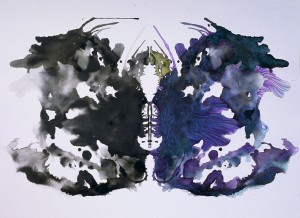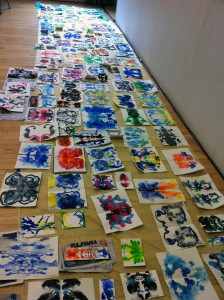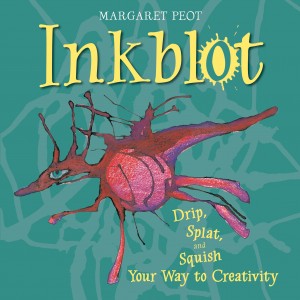Eight Steps to Sidestep Artists Blocks, Part 1

(Four this week and four next week–it started to be the blog post that ate New York. So stay tuned!)
I got a lot of great comments and questions on a recent post at margaretpeot.com (http://www.margaretpeot.com/1016/free-book-giveaway-the-successful-artists-career-guide/) (check out the comments section), when artists wrote in to ask questions about making a living as an artist. While the preponderance of questions were about practical steps to take, I got a few comments about artists blocks–how being blocked artistically was keeping these artists from making a move anywhere–in their studio (or in to their studio), much less taking a first step towards a dream career in the arts.
Artists blocks can be caused by different things. Sometimes it is because the inner drama in our busy minds is too loud to squeeze an artistic thought in edgewise. Or because we can’t get into the studio (or our creative space) because we keep putting it off til tomorrow (see Ten Steps to Combat Procrastination http://www.margaretpeot.com/1066/ten-tips-to-combat-procrastination/). Sometimes we have been so long getting into our creative spaces (literal and figurative) that in order to work in them, we have to get a bulldozer and clear out first. Or, there are a parade of inner critics that come and sit around our studios like vultures, waiting for that creative thought, so they can pounce on it and eat it. Do any of these things sound familiar? Or is it something else for you?
Here are the first four (of eight, ultimately!) tips for mitigating or sidestepping creative blocks:
1. Inkblots: One of the best techniques for getting past creative blocks is making inkblots and drawing into them.
You will need:
India ink (black ink is always best to start, but color is fine, optional)
a squeeze bottle with water
paper (a light to medium weight drawing paper works), enough to make about twenty inkblots–so if you have large sized paper, you might want to tear it into smaller pieces.
a black, preferable acid free, gel pen
colored pencils
How to:
-Prefold a piece of paper. Put a couple drops of ink and a couple drops of water on a half. Fold and press down with the flat of your hand. Unfold and look–what do you see? Repeat this so that you have at least twenty inkblots. (You might not be able to stop making inkblots, and that would be success all by itself, so keep going!)

-Wait for the inkblots to dry, and then look through them. You might start to see images in the inkblots–creatures, landscapes, flowers, trees, monsters, beetles.
-If you find an inkblot in which you see something, draw around what you see with the gel pen, and then color that with colored pencils. Do you see a bird? Outline it and color it in. Do you see an abstract design? Color that. Turn the inkblots upside-down and look. Look in the negative space.
**If you don’t see anything at first, be patient with yourself. Look through the inkblots before you go to bed, and when you get up in the morning, look through them again. Your subconscious will have worked on it in the night, and you will see something in the morning!**
2. Move: Where do you usually work? At an easel? Then take your materials to a table, and work flat one day. Do you usually sit while working? Then stand one day, if possible. Try taking your art materials with you to the floor and sit like a kid with them spread around you. Or take a sketchbook (or some small paper) and a pencil on an outing–to a park, on the subway, to the zoo. Sit in a busy cafe and draw or write.
3. Work on a Schedule: When you show up at a specific time every day to make something (or try to make something), your mind starts to relax– “Oh, yeah–this is the time I get to do something creative!”. So even if you don’t have a thought in your head about what to do or how to proceed, get into your studio at a specific time every day–even if it is just an hour. Look through art books and bookmark things that you like. Cut paper to size. Make inkblots, do automatic drawing, stretch a canvas and gesso it. Do something for an hour every day.
4. Tea Party for Critics: Do you have a cadre of inner critics that come with you into the studio, sitting around smoking, moaning with despair or exasperation over your every move while you try to think of ideas? Identify them. Who are they? An art teacher–alive or long-dead? An unsupportive family member or acquaintance? An as-yet-unidentified “Art Dealer?”
Invite the inner critics to tea–not the real people, but the inner critics that come into your mind when you are ready to work. I’m serious. This is a ritual which is very powerful if you take it seriously. Put teacups on a table (outside of your studio) for as many inner critics as you have identified, and a plate of cookies. Put a stack of interesting magazines, the newspaper, some books. Make tea–real tea. Pour it into the cups. Say to the table of cups, cookies and interesting things to look at, “Thank you so much for all your help all of these years. I have something to do at the moment, but will be back in an hour or so. Please enjoy the tea and cookies!”
And off you go to your studio. Without them. You may only have to do this once. Sometimes those voices (and they are, of course, YOU) just want to be acknowledged. They have worked so hard to protect you from disappointment all of these years and will be happy to take a break from it.
For more information about making inkblots, drawing into them, and making things from inkblots, check out my book: Inkblot, Drip, Splat and Squish Your Way to Creativity (Boyds Mills) at Amazon http://amzn.to/1fZo9Cm, you can buy the book, and also “look inside.” And, please go to my dedicated Inkblot website: http://www.theinkblotbook.com/

